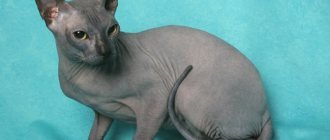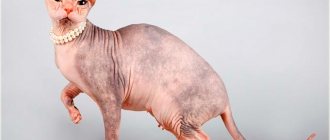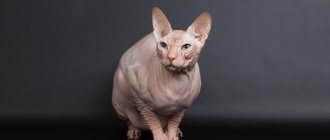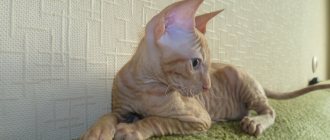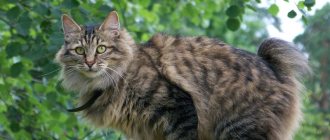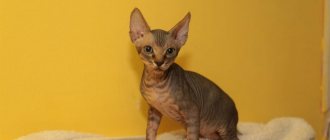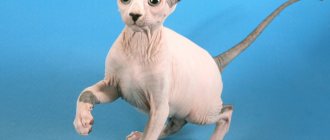Nowadays cats with a lack of hair will not surprise anyone. The current varieties of sphinxes evoke a smile, curiosity and a desire to touch the delicate skin of a hairless cat. But just twenty years ago, this breed evoked a mixture of horror and admiration.
Graceful animals with a mysterious look instantly captivated cat connoisseurs, and a boom swept across the planet, leading to the development of selective breeding. Attempts to breed a new species led to unexpected results.
By the way, these luxurious beauties are usually called not bald, but naked. Friendly pets with an exotic appearance have a good-natured character and an advantageous feature for people suffering from allergies is the lack of thick fur.
Origin story
First of all, the difference between these two breeds lies in their origin.
Their homeland, as their name suggests, is Canada, or more precisely, the city of Ontario. It was in this second largest city in the country that the purposeful breeding of unusual hairless cats first began in the sixties of the last century.
It all started with a hairless kitten, born to an ordinary domestic cat, which, due to the lack of fur, was significantly different from its brothers and sisters. The amazing baby was named Prune. He turned out to be a carrier of the gene responsible for hairlessness.
But Prun was not destined to become the founder of a new unique breed of cats, since the breeders made one serious mistake. They crossed Prun exclusively with his sisters and nieces, and after several generations, the kittens, due to such close family ties, were born weak and often died a few days after birth.
Perhaps the world would never have known about the Canadian Sphynx if not for another hairless cat who was born in the American city of Wadena, and who was named Epidermis. American breeders turned out to be more cautious than Canadians, so they tried to find a cat to mate with Epidermis, with whom he would not be connected by blood ties.
There is a version that the Americans still managed to find distant descendants of Prun, who, together with Epidermis, were used for selection work to develop a new breed. This time, the breeders were lucky and were able to get several generations of completely healthy hairless kittens. The new breed was called the Canadian Sphynx, in honor of the first hairless cat born in Canada.
Don hairless cats are more than thirty years “younger” than their Canadian counterparts and appeared a thousand kilometers from America - in the Russian city of Rostov. Their story began with the bald cat Varvara, who was sheltered by a woman with a kind heart, Elena Kovaleva. Convinced that the pet’s hairlessness was due to some unknown disease, Elena even turned to veterinarians to cure her. But Varvara surprised her mistress by giving birth to babies as hairless as herself.
Russian breeders became interested in the unusual hairless kittens and wasted no time in starting selection work to breed them. The Russian sphinxes received their name in honor of the mighty deep river - the Don.
The difference between these two breeds is not only in their origin, but also in the fact that Canadian Hairless cats are today recognized by all international cat organizations, while the Don have received the status of only an experimental breed.
Content Features
Many people get hairless cats in order to avoid endless combing and cleaning up fluff throughout the apartment. But, alas, sphinxes are far from the easiest breed to keep. If you want your pet to be in excellent shape and in a good mood, you will have to constantly spend a lot of money and time for this. And here’s a paradox: the less fur a cat has, the more expensive its beauty requires. In this sense, velor is the optimal coating option.
To wash or not to wash?
These amazing cats are special in everything - and in their care too. They are neat and very clean, but their own washing is still not enough; the owner must help the pet care for sensitive skin so that irritation and dermatological diseases that hairless animals are prone to do not occur. Mandatory hygiene for sphinxes has much in common, but there are also differences - depending on the type of coat.
All sphinxes are amazingly clean
All cats of this breed group “sweat”: their sebaceous glands secrete a special lubricant that cannot be distributed throughout the fur and remains on the skin. Without such natural nourishment, the skin will dry out and begin to peel. As soon as, while stroking your pet, you notice that your palm is dirty, it’s time to arrange a bath day.
Starting from the age of two months, “rubber” Sphynx cats are bathed weekly, using only special shampoos for hairless cats. Such frequent washing usually does not irritate the delicate skin and does not provoke allergies.
But you can also use other cleaning products, for example, special cat wipes. Velor cats can be bathed less often - once or twice a month as they become dirty - and you can also wipe off dust and dirt adhering to the skin with napkins - especially a lot of it collects in the groin and armpits. Too frequent bathing is not beneficial for any cat, including a hairless one. Remember also that cosmetics (creams, gels, lotions and conditioners) are suitable for sphinxes only with a certain acidity - with a pH of 3.8 to 4.5.
Hairless cats love to splash in warm water
The tail requires special care, the sebaceous glands on which are often clogged, inflamed, and covered with black dots - acne. To prevent this from happening, the tail should be washed with special products more often than the entire cat. The large eyes and huge ears of sphinxes also come into the area of increased attention - they must be kept clean so that there is no risk of infection. Like all cats, you need to monitor the condition of the teeth and claws of “baldy cats”.
Warm and satisfying
Warmth is the main condition for the happiness and health of any Sphynx. In the house where he lives, cold and drafts must be strictly prohibited. Warm beds, cozy clothes made of soft fabrics without seams - all this is included in the mandatory arsenal of the sphinx owner. If you do not provide the animal with a comfortable temperature, it will try to warm up near heating devices, where it can get skin burns. Also, exposure to direct sunlight often results in burns.
These cats always want to stay warm
Hairless cats that are always freezing are characterized by an accelerated metabolism and, as a result, an increased appetite. It is very important to correctly maintain a balance between the quantity and quality of food in the daily diet of such animals. Only practitioners with extensive experience can create a menu of natural products, so breeders usually recommend that those who get Sphynx dogs for the first time select ready-made food based on the tastes, health, and individual characteristics of their pet.
The following are considered the best ready-made food for sphinxes:
- Orijen Cat & Kitten (Canada) – holistic food;
- ACANA Grasslands for Cats (Canada) – holistic food;
- Purina Pro Plan Delicate (France) – super-premium;
- Royal Canin Sphynx Adult (USA, France) – premium class;
- Hill's Science Plan Adult Lamb (USA) – premium food.
The excellent condition of the skin and coat of your velor beauty is an unmistakable signal that the feeding regimen and menu have been chosen correctly. Pay special attention to the diet of sterilized animals.
A properly selected diet is very important for the Sphynx
As for breeding hairless cats, it is better to leave this complex topic to the professionals. Breeding work with all breeds of sphinxes is not only practice, but also a real science in which, alas, there are fewer discoveries than disappointments.
Finding a parent pair of sphinxes is not an easy task.
Description of the breed
The appearance of these animals is unusual - they have hard hair on their muzzle and paws, and the same on their tail. Sometimes there are specimens in which fur grows exclusively on the legs and the body is bald. Here are the distinctive features of all these animals:
- The fur is coarse, slightly curly. As a rule, babies are born with normal fur, and only then does it thin out. In the fall, many people grow longer hair - they are insulated for winter - and in the spring everything falls out, only the paws and tail remain hairy.
- They have no eyebrows, their skin is velvety, like velor, their mustache may be either absent or curly.
- The eyes are angled and oval.
- The back is strong, muscular, straight, the tail is also straight, the limbs are of medium length, thin, graceful, strong, the fingers also seem elongated.
- The tail is thin and elongated, rounded at the end.
- The head is wedge-shaped, the cheekbones and brow ridges are clearly visible.
- The muzzle is medium, the nose is without depressions or humps, the chin is small, the ears are large.
- The colors vary. The most common species are white, blue, red, black and sometimes lilac.
- The size is usually small, but there are also large cats.
- The skin is soft and wrinkled, elastic, and there are wrinkles on the head, tail, paws, neck and belly.
- There is no musky smell, males rarely mark territory.
- Females are smaller, they have a narrower chest, thin neck and small head. The weight of the animal is three to five kilograms.
- The lifespan of the animal is twelve to fifteen years.
- Babies' eyes open a few hours after birth.
There are three subtypes of hairy sphinxes:
- velor, whose hairs are sparse, short and dense,
- point, distinguished by velor hairs on the body and curly, short, coarse hair on the paws, tail and muzzle,
- dense, with hard and frequent fur, through which the body cannot be seen.
Health
Hairless Don Sphynxes are characterized by good health. However, the lack of a fur coat makes the breed susceptible to drafts, which often causes respiratory diseases. The Don cat rarely has cardiovascular problems. But pets often suffer from inflammation of the sebaceous glands and dermatitis caused by poor care or allergies.
Despite the good health of the Don Sphynx, the description of the breed suggests the presence of possible defects:
- microphthalmos, threatening vision loss;
- undershot, in which the lower jaw is noticeably shorter than the upper;
- turning up of the eyelids, making it difficult to blink;
- nipple hyperplasia;
- curvature of the tail;
- cutaneous vasculitis.
The life expectancy of the Don Sphynx is strongly influenced by the risk of “sleeping kittens” syndrome. An abnormally developing thymus can cause the death of babies. A Don Sphynx patient with chlamydia, whose mating was not planned, can infect the offspring, which leads to the risk of a defect.
Don Sphynx
At the end of the eighties of the last century, the first hairless cat was born in Rostov-on-Don. From her the Don breed of sphinxes began. In the Don breed, baldness is caused by the presence of the dominant Hbl allele in the genotype. There are four main groups of this type: naked, flock, velor, brush.
Holoborn ("rubber")
The name speaks for itself - kittens are born without a hint of fur. Moreover, they may lack mustaches and eyebrows, as well as sensitive hairs on their paws. The skin of such animals resembles rubber or plasticine; it is warm, sticky, with a large number of folds on the head and body. Babies can be born with their eyes open, as is the case in humans.
We recommend reading: Groenendael - description and characteristics of the breed
The elastic, thin skin does not yet have its final color. The future color of the animal (blue, black, spotted) can be recognized by the pads on its paws. Some individuals grow sparse fur in winter, but it disappears in spring.
Larger animals remain naked with many folds throughout their lives. They are of great interest to breeders.
Flock
Kittens are born with barely noticeable fluff all over their skin, like peaches. The tactile sensations from touching their skin are very pleasant and unusual; cats resemble plush toys. By the age of two, the hair becomes thinner, the hair follicles die off, and the animals become completely bald.
Velours
Velor, like flock, only visually looks bald - when you take the kitten in your hands, you feel soft fluff all over the body, like lint on velor fabric. Unlike flock, the hair on this type of animal is longer and thicker, especially on the face, paws and tail. The top of the head remains completely bald. By stroking your baby against the grain, you can notice how quickly his even hair is restored.
Velor kittens are divided into types based on the condition of their coat. Lightweight - has a minimum hair length of two millimeters. They are thicker on the paws than on the body. Some kittens have coarse hair, others have soft hair. There is no hair on the top of the head.
Point - the coat has a relatively long pile (four millimeters) on the face, tail and limbs. Points appear in winter, then their expressiveness decreases.
Downy appearance - the cat is completely covered with delicate wavy, rather long hair. In addition, the animal has a surprisingly cute tail.
By the time of puberty, the velor Sphynx becomes completely bald and only some cats walk around with a remnant of fine hair on their paws and head.
Brush
Brush translates as “bristle-bristled.” The fur of these animals really looks like an old brush - hard, sparse and twisted. There are animals with bald heads, necks and limbs. This species is used to maintain the population, but they have no value for the breeder, and they cannot expect titles at exhibitions. Brush are good as one of the parents for the continuation of the species. The fact is that you cannot cross two naked individuals - this leads to mutations and stillborn kittens.
The Brush can shed its fur by the age of one and a half years, but this does not apply to the dense type. His fur is so thick that his skin cannot be seen through it. The tail is especially well covered with it, as well as a lot of hair on the paws and chest.
Advantages and disadvantages
Don Sphynxes have many advantages:
- Cats get along well with children and other animals.
- Pets show sensitivity towards the owner.
- High intelligence allows sphinxes to learn quickly.
- The ability to easily adapt helps the Don breed get used to a new home.
- The animal shows devotion to its owner.
Having told everything about the Don Sphynx, it is important to mention some of the breed’s disadvantages:
- Love for the owner manifests itself in the form of strong obsession.
- Excessive cleanliness makes cats demanding of constant cleaning of the tray.
- The thirst for attention makes the Don cat get in the way.
- A loud voice makes a lot of noise, especially during mating season.
- Skin secretions leave stains on furniture upholstery and clothing.
this breed about the breed except the sphinx the breed in general of any purebred animal a cat of the Donskoy breed about the breed all the subtleties of the breed in Hypoallergenic cats Hairy were ordinary cats keeping a cat pronas cat lives cat saliva wow these cats are like your own cat “hairless” cats from Cat breeds Cat breeds I adore cats often need it
feedingrodentsmeauthorcontentsharevideophotostorybackotherfacebook
Types of Sphynx coats
Brush animals were not bred on purpose - they appeared as a result of a gene mutation after crossing different types of cats. There are several types of Sphynx with fur, differing in the length and type of hair.
Flock
The body of pets is covered with a thin velvet pile, similar to the fluff on the surface of a peach. The fluff is very soft to the touch and almost invisible. The densest coat is found on the paws and tail. In the absence of developmental anomalies, by the age of 2 years all the hairs fall out on their own, and the animal’s skin is completely exposed.
Velours
The velor pet of the Sphynx breed has a bald head, and the hair length on the body reaches 2–5 mm - in appearance they resemble partially bald street cats. Most often, by adulthood, these animals also become bald, but sometimes the fur remains throughout their lives. Often the lint remains only on the paws and tail.
Brush
Pets of this breed differ in the density of their coat:
- Brush velor Sphynx kittens have hard hair that resembles stubble. On the sides and neck the fur is thinner, the skin is visible through it. With age, the fur can soften, and then the velor brushed Sphynx becomes more similar to representatives of the flock breed.
- After birth, the body of the Pointed Brush is covered with long and thick hair, and a barely visible bald patch stands out on the head. By 18–24 months, the length of the hair on the body remains about 1–2 mm, and on the tail, muzzle and paws the hair reaches 10 mm, becoming curly in some places.
- A kitten of the dense brush breed looks like an animal with straight fur - it does not have a bald spot on its head. Over time, the structure of the hairline changes - it becomes thick, and the skin is practically not visible through it. On the paws, chest and tail, the hair is longer and stiffer, and can be either straight or curly.
Note! Pets of this breed do not take part in exhibitions, but they are crossed with other types of sphinxes - this allows them to get strong offspring. This selection is due to the fact that when two representatives of hairless sphinxes are brought together, very weak or dead kittens are born.
Straight-haired
Straight-haired Sphynxes do not go bald over the years - they still have short hair that fits tightly to the skin, and pronounced, long whiskers. The breed appeared as a result of the mixing of Siamese or Oriental cats with Sphynx cats.
We recommend reading: Bullmastiff: everything about the dog, photo, description of the breed, character, price
Character and special habits of brushes
These cats can be characterized as playful and inquisitive. Over time, they become full-fledged members of the family. They choose one master or favorite for themselves, they always obey him unquestioningly, carrying out all his commands. They treat other people with warmth and good nature. Also, the Sphynx Brush is intelligent, but tends to be touchy. However, he is not vindictive. You should not punish this animal physically and psychologically.
Brushes can be called empaths, capable of sensing changes in a person’s mood. They react to this, trying to pity and cheer up the person. Cats love affection, all kinds of manifestations of tenderness, care, and attention to themselves. This breed is characterized by quickly getting used to a new place, observing all the requirements that the owners place on them. If the animal refuses to visit the tray assigned to it, you just need to move it to another place.
Sphynx kittens.
Sphynx brush colors
Brush Sphynx cats can have a wide variety of colors, among which the following types of colors are distinguished. There is a specially developed table of brush color codes in which you can see the identity of your kitten.
Sphynx color coding table.
Material on the topic: popular colors of the Scottish cat breed.
Plain
This type is also called solid color or solid color. With this type, the cat has a uniform color over its entire surface.
- White. This color is found in all cat breeds.
- Black. It can range from a deep rich color to gray, depending on the thickness of the coat.
- Blue. This color is a variation of the black color, but can be confused with it. To accurately determine the exact color of the animal, it is determined by the color on the stomach, eye rims, lips and testicles.
- Red. This color always has a tabby pattern. Sometimes this color can be confused with cream.
- Cream. A variety of red color.
- Pink sphinx.
Rare colors
These colors include various tortoiseshell colors, which are most often found in cats. There are different varieties of this color:
Sphinx Brush at three years old.
Black turtle - combination of red and black;
- Blue - a combination of cream and blue colors;
- Turtle cinnamon;
- Turtle cream;
- Turtle Lavender.
There are other colors of Sphynx brushes that are also common among these cats:
- Chocolate. This is one of the black color options. This color is considered rare and does not occur often in this breed.
- Lilac. A type of chocolate color, but in light shades. Also applies to rare colors.
- Particolors. This can be bicolor and calico and the so-called calico chintz. It is a combination of tortoiseshell color combined with white.
- Color point.
- Tabby. There are several varieties of this pattern - marble or classic, tiger.
Rarer and more expensive tabby colors, which are especially valued among breeders, are:
- brown tabby;
- silver tabby;
- blue tabby;
- red tabby;
- cream tabby;
- chocolate tabby;
- cinnamon tabby;
- lavender tabby;
- fawn tabby.
The type of color does not affect the length of the animal's coat; the average hair length does not exceed 5 mm. and may vary depending on the molting period and other influencing factors.
Brush sphinx.
Description of what it looks like and what colors there are
Any colors of the Don Sphynx are allowed, except lilac and chocolate. There are purebred Donchak dogs:
- white;
- black;
- gray;
- red;
- blue;
- red;
- pinkish.
Tabby-colored cats (patterned, striped) are also recognized by the felinological community, but they are classified into a separate subgroup, without division by pattern.
And here you will find the schedule of WCF cat shows for 2020.
Health and disease of the Brush Sphynx
Once every three months, the cat needs to be prevented from worms, and revaccinated once a year, according to the recommendations of veterinarians. One of the most common problems these animals face is diseases associated with the skin - dermatitis, irritation, rashes, etc. Congenital pathologies are rare in this breed, but they can acquire diseases that are more characteristic of them.
- Microphthalmos. A congenital pathology of the eyelids, in which the eyeball is smaller or underdeveloped, which can cause poor vision or complete blindness. The reasons for this have not been fully identified and are only being studied. With this pathology, veterinarians simply remove the damaged eye and, if possible, perform plastic surgery.
- Short lower jaw. Most often, this pathology occurs among Donetsk residents. In this case, an incorrect bite occurs, the jaws come into contact with each other and do not completely align.
- Turning of the eyelids. Characterized by weakening of the muscles of the eyelid ligaments. Solved surgically.
- Dermatitis. Type of skin disease.
- Nipple hyperplasia. It is often transmitted genetically through the female line. The risk group includes females with light blue tones.
- Trichophytosis. The type of fungal disease is similar to lichen.
The breed is distinguished by its strong health. If you follow proper care, a balanced diet, contact veterinarians on time and get all the necessary vaccinations, your pet will be a joy for a long time. They rarely get sick, thereby causing their owners trouble and expense.
How to toilet train a Sphynx
Sphynxes are clean animals and are easily litter trained. If your pet ignores the toilet, it means he doesn’t like something. Try choosing a different tray or experiment with fillers. Do not use physical force or scold your pet during training.
Do not miss
- Do not miss
How to train a kitten to use a litter box in an apartment: step-by-step instructions
It is not recommended to use silica gel filler: the baby may accidentally swallow the “balls” and get poisoned. Life hack: before pouring the filler, place the bag on the tray - this way the plastic will not absorb the smell. During cleaning, collect the film and throw the granules into the trash.
Skin care and bathing
The Sphynx breed, due to its physiological characteristics, needs more frequent bathing than their furry counterparts. This procedure must be done correctly so that the cat does not experience stress and avoid health problems. It is better to do this in a shallow container or bath; the depth of the water should not exceed 15 cm. Cats are often frightened by the stream of flowing water.
It is recommended to use special care formulations or products for children as shampoo. They do not contain harsh ingredients that can cause irritation, and this breed has very sensitive skin.
Sphinxes have a high temperature, so they need to be washed with preheated water. The optimal temperature should be 36-39 degrees. When washing an animal, you need to calmly talk to it and stroke it so that the animal remains calm and does not get nervous. The amount of shampoo depends on the degree of soiling of the cat.
We recommend reading: Types of bulldogs: an overview of the main varieties of the breed
Table describing care procedures for Sphynx cats.
In some cases, you can do without it altogether by simply bathing it in warm water. When bathing, water should not get into the animal's ears, as this can lead to inflammatory processes. In this case, it is not recommended to wash your hair at all; you can use wet wipes.
It is not recommended to wash kittens that have recently been given a new home and have not yet had time to adapt to their new living conditions. The Sphynx should be bathed at least once every ten days. After bathing, the animal should be thoroughly dried and the room should be warm. Otherwise, the cat may catch a cold.
Sphynx kitten at six months.
Rules of care
These cats do not need serious care:
- Sphynx Brush cats are fed natural or premium dry food. Also, the cat’s body constantly needs a large amount of fluid and properly selected vitamins.
- Don't forget that the Sphynx Brush's ears and teeth need regular cleaning. Optimally - once a week.
- Brush cats need to be bathed regularly. You can buy a special product or take a good baby shampoo.
- Cats don't have eyelashes, so pay attention to their eyes. This is especially true for kittens - it is better to wipe their eyes with a damp, clean swab once a day.
Important! The hair of a plush Sphynx can change due to a new diet, temperature, humidity in the room, changes in hormonal levels during gestation or estrus.
Breeding
To breed Sphynx Brushes, the animal should be purchased from a professional, registered breeder. The most expensive are the naked ones, the sphinx velor is cheaper, while the brushes themselves are of average cost. The cost is affected by the gender and color of the animal. It may be difficult to find a partner, since in Russia this breed is not considered the most popular.
How to choose a kitten?
You need to choose a kitten based on its health, knowing its pedigree. The kitten must have documents indicating its parents and grandparents. The kitten itself should be playful, active, and moderately inquisitive. There should be no discharge from the eyes and ears; this may indicate possible health problems. The animal must have all the required vaccinations and a veterinary passport with vaccination marks.
Choosing a name
It is necessary to choose a name based on the individual characteristics of a particular animal. This could be his character, origin story, interesting facts related to him.
How to care for brush cats
No special care is required for the brushes. In this regard, they are not much different from other sphinxes.
These cats need:
- Daily wiping of the eyes with damp swabs or wipes soaked in a special eye care product, herbal decoction (chamomile, calendula) or tea leaves.
- Clean your ears at least once every 5-7 days to remove dust, dirt and sulfur secretions. Use cotton pads and swabs with a specialized solution for caring for the ears of animals or pharmaceutical preparations (hydrogen peroxide, chlorhexidine).
On sale you can find special wet wipes for caring for the eyes and ears of animals.
- Skin care, which consists of: periodically wiping the skin with a damp sponge or cloth to remove the brownish secretion produced;
- combing existing fur (about once a week) with a stiff hair brush or a simple short-toothed comb;
- bathing when soiled (preferably no more than once a month) with a special gentle shampoo for sphinxes or baby soap;
It is better to wash sphinxes with a special shampoo.
- additional moisturizing of the skin with nourishing cream or cosmetic oil.
Thanks to the presence of wool, brushes freeze less, but in cold weather they still need warm clothes.
A good friend of mine has a Sphynx living in her apartment. It was not possible to determine the exact breed, because they bought it second-hand from an advertisement for very little money. The cat has a completely bare back (almost rubber), but everything else is covered with short, sparse fur. Funny spiral-shaped broken antennae stick out on the muzzle. You have to wipe the skin several times a day, because the animal constantly sweats and at the same time becomes covered with a sticky, waxy yellowish coating, which has a rather unpleasant characteristic odor. To keep the cat warm, a short flannel blouse is always put on it. The cat's claws are cut very often (once a week), as he begins to itch intensely when he sweats, and at the same time scratches himself until he bleeds, leaving deep and long-healing scratches.
Video: how to care for a Sphynx
Advantages and disadvantages of plush sphinxes
Adult Don Sphynxes reach 30 centimeters at the withers, males look larger, and their weight ranges from 6 to 7 kilograms, while females weigh no more than 5 kilos. With proper care, representatives of the Brush breed live 14–17 years.
Interesting! The Sphynx Brush's body temperature fluctuates between 38-39 degrees, so when you touch your pet's skin it feels hot.
Advantages of the little hairy dog of this breed:
- friendly attitude towards children, lack of aggression towards other people;
- high intelligence, ability to train;
- easy contact with other animals;
- cleanliness;
- long lifespan, provided proper maintenance;
- absence of fleas and hair around the house.
A hairy pet also has a number of disadvantages:
- the need for regular skin care;
- the importance of maintaining the correct microclimate in a living space;
- increased susceptibility to dermatological type pathologies;
- specific body odor;
- insatiable appetite, increasing the risk of obesity.
Character
Velor beauties are very affectionate
Don Sphynxes are friendly cats. These are companions who are happy to spend time next to people: they love to lie on the couch with their owner, and run after a person around the apartment. Purrs, as sociable animals, find it sad to be alone for a long time. They are loyal, non-aggressive, but can be offended if the owner swears loudly.
The tailed cats of this breed are comfortable with living with dogs and other medium-sized pets. In addition, they get along with children: they are ready to play with kids and do not scratch. Animals are especially active when they are young. Adult cats prefer a quiet rest, but sometimes they are not averse to frolic.
Don Sphynxes are distinguished by their intelligence. They can be trained. But at the same time, you cannot roughly force the animal to obey, otherwise the pet will become stubborn. It is better to use the reward method - for each execution of a command you need to treat the cat with a treat. Hairless purrs can learn different tricks. Tailed animals are able to understand the requirements to “sit” and “lie down”. They love to fetch the ball.
Why does the Sphynx begin to grow hair?
Kittens and adult Sphynx cats sometimes begin to grow hair. There may be several reasons.
- Cold weather.
With the onset of cold weather, most sphinxes are covered with short fluff; in some areas of the body the hair can be quite long. It can grow back even if it only got cold outside the window, but the temperature in the house was always maintained at a comfortable level. - Heredity.
Canadian Sphynxes are the most stable breed. The appearance of fur on them usually indicates the “sins” of the breeder and accidental interbreed matings. You can expect everything from Donetsk, Peterbald, Levkoy and other hairless breeds. They are on the path of becoming. It happens that kittens do not shed their fur and this cannot be predicted, and adult cats can grow and remain fluffy. - Hormonal changes.
Wool can grow rapidly or, on the contrary, fall out as a result of puberty, pregnancy, castration/sterilization, disruption of the endocrine system and other factors affecting the general hormonal balance.
Observations show that reasons such as feeding, illness, stress in combination with the above can affect the amount of hair in a hairless cat.
Regardless of the amount and length of the sphinx's fur, the character and habits usually do not change. Even in their fluffy form, they remain very gentle and sociable creatures who adore warmth and comfort.
Sources
- https://MyFavoritePet.ru/poroda-okras/pochemu-sfinks-pokryvaetsya-sherstyu.html
- https://medeponim.ru/pitomczy/samye-laskovye-i-umnye-domashnie-pitomczy-sfinks-s-sherstyu-volosatyj-opisanie-i-harakter-porody
- https://vplate.ru/sfinks/s-sherstyu/
- https://MoiKoty.ru/porody/sfinksy/brash
- https://ProKota24.ru/porody-koshek/sfinksy/sfinks-brash
- https://usatiki.ru/koshka-sfinks-s-sherstyu/
[collapse]
We recommend reading:
- An enclosure for a dog: how to make a beautiful warm outdoor enclosure with a winter road with your own hands - drawings, sizes, photos, projects, tips on how to build it yourself
- Features, varieties and photos of hypoallergenic cat breeds, how to care for them
- Caring for a dog's fur: how and what to comb properly, combs for long, short-haired, smooth-haired dogs, how to comb tangles, products - shampoo, spray
- Gampr (Armenian Wolfhound): all about the dog, photo, description of the breed, character, price
Reviews
All owners of such tailed animals are very happy with them, it is impossible not to fall in love with them; as a rule, such pets become loved by all family members, even if someone is initially put off by their appearance. Cats of this variety are disciplined, easy to train and raise, and love to be photographed.
They are loyal and love their owners, meeting them at the doorstep and following them around the house everywhere. They often sleep in bed with people, love to purr on their knees and sleep in the warmth of human hugs.
To read: Secrets of proper nutrition for Bengal cats and kittens: what is healthy to feed and what is strictly prohibited?
Some take in adult animals, and they still quickly adapt to the new environment. They love children and easily find a common language with other representatives of the animal world. They do not spoil wallpaper and furniture, especially if you accustom them to scratching posts from childhood. They always go to the toilet in the litter box. The only thing that can be a problem for busy people is daily wiping, but for those who are already used to it, caring for a cat is a pleasure.
How to choose a kitten
You can reserve a photo of the Don Sphynx before purchasing. However, a visit to the nursery is mandatory to examine the kitten and its conditions of detention.
Healthy Don Sphynx kittens must meet certain characteristics:
- age more than 3 weeks;
- friendly disposition;
- availability of vaccinations and general healthy appearance;
- soft smooth skin;
- fatness;
- rounded, elastic belly;
- clean eyes, ears and nose.
The cost of a Don Sphynx kitten is determined by:
- pedigree;
- breeder's reputation;
- type of coat, regardless of color;
- floor;
- class.
